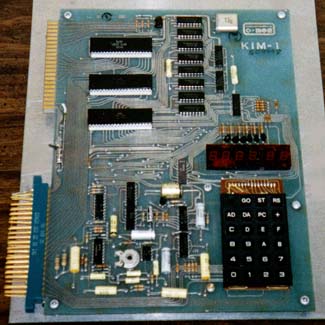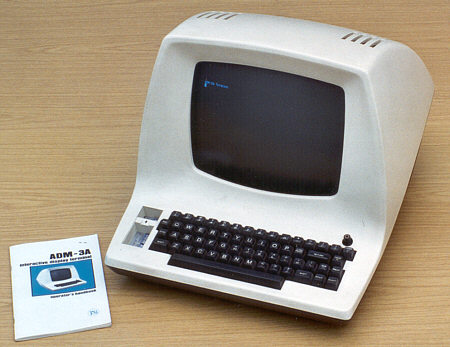Tadd's Computer History
This is a tale of my computers and computers I depended on. It leaves out the lesser machines that were not the main focus of my attention. I'm trying to include the machines that I worked with the most in a given time period, in an attempt to show how expectations of performance and usability vs cost and availability of equipment have changed over the decades.
My lust for a computer of my own starts in Sophomore year of High School. I had just moved back to New Jersey (my dad was transfered overseas for a year and took the family with).
September 1975
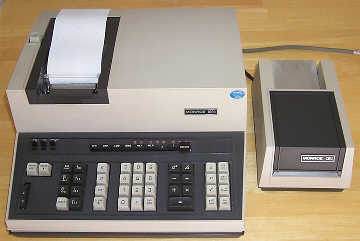 My high school had a pair of Monroe programmable
calculators. I believe that the model numbers were 1665 and
1880. These machines executed sequences of octal tokens.
Most of the octal tokens represented keyboard operations.
Thus, 30 + 125 = would be encoded as seven instructions.
There were also instructions that were not available on the
keyboard. Some of these were pretty weird and would be used
to manipulate the printer. The printer on each calculator
was the primary output device and was capable of printing a
bunch of letters, but each letter had a particular column
that it would reside in, plus 10 or so columns of numbers,
signs (+ or -), decimal point, etc. Typical calculator
stuff. The 1665 also had a binary display, organized on the
top of the keyboard to show what octal instruction was being
executed. I believe that the 1665 could handle 100 or so
instructions. The 1880 could take 500 or so. The 1880 had
the additional capability of reading and writing magnetic
cards to store programs or data. I remember calling Monroe
in Morristown on the phone and having them send me a handful
of magnetic cards. I think that the Monroe company donated
the machines to our school. Both calculators lost all
programming info and data when the power was removed. Both
were AC operated and were rather loud when printing.
My high school had a pair of Monroe programmable
calculators. I believe that the model numbers were 1665 and
1880. These machines executed sequences of octal tokens.
Most of the octal tokens represented keyboard operations.
Thus, 30 + 125 = would be encoded as seven instructions.
There were also instructions that were not available on the
keyboard. Some of these were pretty weird and would be used
to manipulate the printer. The printer on each calculator
was the primary output device and was capable of printing a
bunch of letters, but each letter had a particular column
that it would reside in, plus 10 or so columns of numbers,
signs (+ or -), decimal point, etc. Typical calculator
stuff. The 1665 also had a binary display, organized on the
top of the keyboard to show what octal instruction was being
executed. I believe that the 1665 could handle 100 or so
instructions. The 1880 could take 500 or so. The 1880 had
the additional capability of reading and writing magnetic
cards to store programs or data. I remember calling Monroe
in Morristown on the phone and having them send me a handful
of magnetic cards. I think that the Monroe company donated
the machines to our school. Both calculators lost all
programming info and data when the power was removed. Both
were AC operated and were rather loud when printing.
Photo credit to The Calculator Museum.
I liked the Monroes but wanted my own so I started searching the calculator market and finally in 1976 the HP series got cheap enough.
Fall 1976
HP 25 programmable calculator
$150
- I made programs that
- played defense in an interactive Mastermind game;
- solved quadratics;
- played an interactive moon lander;
- calculated the binary programming bits needed to enter a frequency into my Bearcat 101 scanner;
- counted time in hours, minutes and seconds (no digital watches in 1976!).
I went into NYC with my dad when I was a junior in High School to buy this on Lexington Ave. This machine had no i/o beyond the User Interface and could execute about 200 instructions (relatively high level tokenized calculator commands) per second. The memory in this machine was capable of storing about 50 such instructions. At the time, some calculators used their memory to store keyboard clicks as programs. The HP system was actually rather advanced comparatively. These calculators used LED displays and ran on Nickel Cadmium batteries. They would run for 4 or so hours before draining the batteries and needing recharge. The 50 step memory (and all other registers) would be reset to null or empty or erased when the power was shut off or lost. So...I got rather good at typing my programs back into the machine. I could enter my quadratic equation solving program with the calculator behind my back in about a minute.
The thing that felt most limiting with the calculator is that all operations were based on keyboard entry and displayed response. There was no way to make the calculator make a noise, or respond to an input. I considered making a modification to allow an external input to trigger a keyboard action and also considered mounting the calculator underneath a solenoid plunger but still there would be no output capability. One possibility was to pick up RF noise from the calculator over a CB radio or AM broadcast band receiver and built a filter to detected it but in order to have the calculator trigger on whatever it was triggering on, you ended up with trashy RF noise anyway. Also, after spending enough program space to trigger the filter you'd have precious little space for calculating. (I ran into somebody 10 years later that had electrically connected to one of the scan line wires to the LED display and used that to control an external device, not something I would have done until much later by which time I had computers with real i/o)
1977
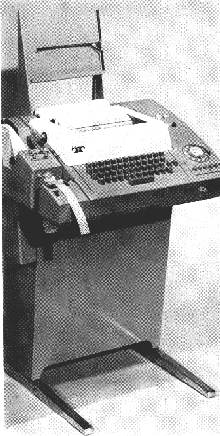 Our High School (and most of the surrounding High
Schools) got hooked up with a time sharing HP2000F system.
Each school got one ASR33 teletype with 110 baud modem and
paper-tape reader.
Our High School (and most of the surrounding High
Schools) got hooked up with a time sharing HP2000F system.
Each school got one ASR33 teletype with 110 baud modem and
paper-tape reader.
We had BASIC and APL and about 100K of storage space for the
school. The editor was command line based and you had to
type the entire line over if you wanted to make changes.
Each line was numbered. You could get a listing from
specified line number to specified other line number. You
could save the files. There was enough room on our storage
area to save about 1000 lines of text file, total. That
storage was for the entire high school. Students used paper
tape to save programs and used that tape to restore the
program before working on it.
In June 1978 I graduated from high school. I had no career goals at that time having been burned on Architecture (which had been my previous career idea). I started working fulltime for Radio Shack in Morristown NJ. Radio Shack came out with TRS-80 Model 1 shortly after. I was pretty good at BASIC so I had fun writing video games.
December 1978
I bought a KIM-1 (6502 machine language hex keyboard and display). I bought this from Computerland in Morristown New Jersey for $189 + $30 for the plastic case. It was a single PC card with 1K of RAM, 2K of PROM (prom integrated in i/o chips) which included i/o drivers for current-loop interface, a monitor for program entry, single-stepping (through code in RAM), 16 bits of bi-directional i/o and display. The machine also came with several pretty decent books on the machine and the processor. I bought another book called "The First Book Of Kim" to help me learn assembly language programming.
|
|
|
Image courtesy of Mind Machine Museum |
Coincident with getting the KIM-1 I was awarded KA2DEW by the FCC as an Amateur Radio (ham) callsign. I was already a scanner buff listing to ham radio repeaters on 146Mhz and already had a Heathkit SB104A short-wave ham radio that I'd bought used so I was pretty well informed as a new ham and also already had ideas of what I wanted to do with my ham radio hobby. I was all ready to integrate ham radio and computers
I used the Kim to do touch tone decoding (with external tone filters), Morse code sender, ham radio repeater controller, Morse code decoder (didn't entirely work -- I had two different programs that communicated but I could only load one at a time into the 1K of RAM), telephone speed-dialer. It was lots of fun. i/o is important! The KIM could execute hundreds of thousands of instructions per second. That means that I could spend an hour entering a 1K program and it could run through the entire thing a hundred times (or do loops or whatnot) in under a second. This was plenty fast considering I was never doing math. Most of my technology was in the use and timing of delay loops. I never used serial i/o on this device, just buttons and sensors in and out. I also made noises by toggling the output lines and driving a speaker through an amp.
One limitation of this device was storage of the programs. The tape cassette interface was pretty good but in practice it wasn't reliable. I would always hand write my assembly language, and hand compile it, into a notebook. Then I'd just be ready to type the program in again at need.
My parents moved us to Nassau Bay, Texas and 3 months later I started at Clarkson College in northern NY. My major was E.E.
Nov 1979
I sold the KIM-1 to help fund the purchase of the best stereo speakers in my dorm after finding out about wire wrap from my brother. He offered me a Tarbell basic in ROM if I built my own z80 machine. He even gave me a schematic, a pile of wirewrap sockets, prototyping wirewrap board, wire and a wirewrapping pencil.
May 1980
After two semesters I gave up on the EE curriculum. Apparently EEs at clarkson (in 1980) didn't get much digital until junior year and spent precious little time with programming. I wanted to program early and often so I started taking computer science courses.
July 1980
For a summer job I worked at a company called Videk, a division of Exxon (later renamed to Exxon Office Systems). My job was mostly grunt work although I did get a few weeks of programming in FORTRAN, and met some engineers including some hams that I still talk to.
I acquired my first synthesizer frequency controlled ham radio which was a walkie-talkie for the 146Mhz FM band. This was a Tempo S-1.
One visit to Heathkit in Fairlawn NJ, drooling over LSI-11 computers, I saw that they had a used H9 dumb terminal. I figured that I could use that for some computer project and it was cheap (under $100 as I recall) so I bought it.
Sept 1980
| During my sophomore year Clarkson ditched the IBM360/65 batch processing computer (R.O.S.C.O.E.) and replaced it with M.U.S.I.C. which was an interactive time-sharing machine based on an IBM4341. | ||
| With M.U.S.I.C. we had compilers for several languages including BASIC, PASCAL, PL1, FORTRAN, WATFIV, COBOL and others I didn't use. | ||
|
The process of creating programs was to use a line editor. It used a command line and had instructions which were a single character followed by parameters. Examples included R KK k which would replace KK with k in the current line. You could select which line would be affected and you could display groups of lines. You could also insert new lines. There were probably 50 commands available, in upper and lower case. |
||
|
The MUSIC system actually had several editors. Some were easier to learn but less powerful. There was also a 'screen' editor that only worked on the IBM 1378 (?) 'smart' terminals. Those terminals were hooked up to the computer by a much higher bandwidth connection. There was only one of these terminals available to the students while there were dozens of Lear Siegler ADM3A 'dumb' terminals which could only use the line editors. The ADM3As were run at a relatively low baud rate, 1200baud as I recall. The screen editor let you use cursor controls to move up and down and left and right in the file you were editing. With a line editor all you could do was insert new lines, and then use command line commands to make changes to lines. |
||
|
||
| The IBM also had telephone modems that were usable by anybody who could call them (and who had an account). The modems worked at 300 baud. To buy one of these for oneself cost about $500 when the system was first put on. | ||
| Programs running on MUSIC were interactive. You could read the keyboard of the local terminal (the one the program was launched from) and a screen editor was quite possible. I was working on one for the fun of it at one point. | ||
| There was a book, available at the book store at the beginning of the semester when the computer was first installed, that was 8.5 x 11 and about an inch and a half thick, that defined the API and other info for use with FORTRAN. I wish I still had that book. I think I gave it away when I left the college. |
Oct 1980
I wrote my own campus email program because the one that MUSIC came with was terrible. Mine was called MOOSE (mailbox oriented operating system with entropy). It included traditional email, real time log-on log-off status of the users, real time chat (only one channel). With this I invented social computer chatting at Clarkson.
The Clarkson e-mail program came in three separate applications. The first was an info utility which was traditionally run as an auto-start on log-in. This told you if you had mail. The second was a read mail utility that immediately dumped your first message on the screen and gave you the option of keeping it, or tossing it. The third was a send mail utility that let you type a message to an on-campus account number (mine was BL6B). After you were done typing the message, you did the end-of-message character and hit return. If the user was currently 'in' the read-mail utility, your got an error message and the text you'd typed was lost. It was quite aggravating.
I wrote a shell. The shell would get launched as the auto-start application. It let you do system commands and launch applications. Each time you did a blank carriage return it ran my info utility which told you if you had mail. Every time you hit a carriage return at the system prompt at all you'd get told, optionally, if anybody who had a MOOSE account had gotten on the system since the last carriage return. Further, you could run a command that told you every MOOSE user who was on-line and what terminal in what terminal room, or what modem, that they were on-line from. My account names were user selected aliases. My read-mail function also blocked the users incoming mailbox but the send-mail function tied it up as well. I'm not sure why both the MUSIC standard mail program and mine had that limitation but I probably wasn't bothered with a better solution. The send and receive portion of the program were some of my first FORTRAN programs.
After I got the shell and send/receive e-mail working, I wrote a real-time chat engine. It had all sorts of kludges because the only way to get it to work involved storing the messages as files and using semaphores to pass the information around between users. There were lots of file transactions for each line typed, depending on how many users were in the chat 'room'. There was only one chat room. The chat looked very much like IRC but without most of the features.
Clarkson Educational Resources Center (ERC) was not pleased. My program was tying up most of the computer terminals at any given time, even though real work was done via the shell.
Credit: I have to credit the impetus for the massive amount of work I did on MOOSE on one man, John Bruno Pfuntner. John and I shared a dorm room. John and I both did completely evil things to each other. At one point after I'd first started MOOSE as a send/receive mail program, I announced to my friends that I would no longer be using the nasty MUSIC e-mail system. I deleted my incoming e-mail file. This made it impossible for somebody to send me e-mail at BL6B. It also made it possible for my roommate to create a public writable BL6B_mailbox file, thus making it impossible for me to recreate the mailbox of my own. John then sent all of my friends MUSIC-mail messages saying that he was BL6B and was being held hostage by terrorists. John wrote his own e-mail sender program to send from BL6B. So, I added a trojan horse feature into MOOSE to detected if the user was John (BL50) and to both delete the BL6B-mailbox file from his account and to send me e-mail when this was done.
John refused to run MOOSE himself, just to be evil. So. I spent about a month making MOOSE so impressive and useful, that all of John's friends would use it. Eventually John wouldn't be able to resist. For a month he harranged me with "help help they are torturing me" messages from BL6B. Eventually he ran MOOSE and poof, the deed was done. John didn't forgive me for at least a semester!
In the process I got a very nice e-mail/chat environment going that lasted for a good 2 semesters after I left the college. Eventually Clarkson (ERC) wrote it's own. It was rather embarrassing to have my program around considering how nasty they were toward me when I first started up MOOSE.
Dec 1980
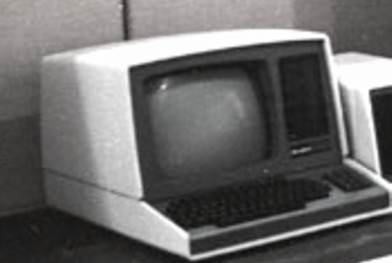 My brother Jay loaned me a Heathkit H-19 'smart' terminal.
The H19 uses the same chassis and case as the Heathkit H89
computer and so has a bit of extra room inside the case.
Jay had built a wire-wrap z80 board with a monitor-in-rom for
it and I was able to use it to write machine language
software for z80. This plus the ability to do memory
displays that filled the screen made it much nicer than the
KIM for everything but program entry. Z-80 was never
designed for Hexadecimal opcodes, it wanted Octal, and the
keyboard on the H-19 wasn't well suited for Hex entry
either.
My brother Jay loaned me a Heathkit H-19 'smart' terminal.
The H19 uses the same chassis and case as the Heathkit H89
computer and so has a bit of extra room inside the case.
Jay had built a wire-wrap z80 board with a monitor-in-rom for
it and I was able to use it to write machine language
software for z80. This plus the ability to do memory
displays that filled the screen made it much nicer than the
KIM for everything but program entry. Z-80 was never
designed for Hexadecimal opcodes, it wanted Octal, and the
keyboard on the H-19 wasn't well suited for Hex entry
either.
photo credit Ken Montgomery
Feb 1981
I acquired a Hayes 110/300 baud telephone modem for about $300 (as I recall). Mine was a direct connect modem instead of an acoustic coupler (cradle) model. This meant that it plugged directly into the phone jack on the wall instead of having the handset lay into the top of the modem like every other modem I'd ever seen.
I never finished my BASIC-IN-ROM EPROM board because MOOSE was just too much fun to play with.
April 1981
I had a great scheme with my z80 machine to log onto both the Clarkson machine and the Potsdam State machine (both in Potsdam NY) via telephone and run MOOSE on both of them. Then I could use the z80 as a shuttle so send traffic between users on the two campuses. Too bad I hadn't heard of TCP/IP at that time. I might have gotten a grant!
I left Clarkson after 4 semesters and moved to Troy NY.
June 1981
In Troy I had a Prime 450 to play with. My brother Jay and a couple of friends started their own company called Raster Technologies. I was hired to program Fortran and do hardware prototyping. Mostly I was supporting (through soldering-iron technician duties) prototyping of the graphics workstation (more of a frame buffer) that Raster was designing and Fortran programming to control the Model One graphics frame buffer. Now that was a machine. It was less than 1/3 the price of the competition. It was a graphics controller that was accessed via RS-232 at 19.2Kbaud. Yes, serial. Talk about throughput! It was actually pretty amazing at the time. It had 3/4 of a megabyte of RAM on a SINGLE 15 INCH SQUARE PC board!! There were 3 other boards for the processor, vector processor, and video drivers. All for under $20,000(US)!
A friend of mine in NJ who worked for Perkin Elmer (sp?) sold me a 'smart' terminal which I used to dial up Clarkson's modems and to access MOOSE and I also used it to access some local BBSs. (I'm not sure what happened to the H-19, I probably gave it back to my brother) The BBSs were single user access. That meant that you could leave a message for somebody else but there was never any hope that anybody would also be on line while you were. Also you couldn't leave a message for somebody at another BBS to pick up. The concept of networking wasn't quite there yet.
Some of the hams were using telephone modems and dumb terminals to send text via FM ham radio. Just about then the concept of doing error correction on blocks of data was becoming known. This was called "packet radio".
In January 1982 I moved to NJ and started a job working for Ecom (a CATV/broadband modem and digital communications engineering firm) doing assembly language programming for Cosmac Elf 1802, and z80 using Futuredata tools. The project I was working on was the TRU-100 cable TV computer communications device. The device participated in a polling network where one station would talk to a couple of hundred other devices and communicate small amounts of data. On the client devices the data would be converted into parallel port data (read or written to i/o ports), serial port data (at 9600 baud or less) and sometimes streams of data logged from the parallel ports and transmitted to the host station. Communications was bidirectional over a low speed link occupying pieces of a pair of CATV channels television channels.
May 1982
I started working on a Xerox 820 I bought for $100 with 64K of RAM. (never really got that working, had bad used 8" floppy drives) system. Mostly I spent lots of hobby time making ham radio repeater controllers. Some of these got quite intense. I had one program that was over a hundred thousand lines long. I trashed the z80 board and sold the dumb terminals. I acquired another KIM-1 and did a bit of work on that. I eventually lent it to a younger guy at work as he wanted to learn interfacing and play with machine code.
The computers my employer had were z80 machines made by FutureData. They had a screen editor, assemblers, linker, and even a debugger that let you test z80 algorithms on the Futuredata itself. The real cool thing my employer had was an HP1611 Logic Analyzer. This device could watch the control signals, address and data bus of the processor, up to 27 total signals, and trace program execution in real time. I got really good at using this tool. The process of writing software for, say an 1802 CPU, was to use the FutureData to edit, assemble, and link the program, burn the EPROM with it's integrated EPROM programmer, plug the EPROM (which held a total of 1024 bytes of program) into the target device, and then watch the execution of the device both with the control panel or other devices it talked to, and with the logic analyzer. It was a slow process but a sure one. There were few times when I'd have to scratch my head and wonder what was happening when things went wrong. With the logic analyzer I could know exactly what was going on in memory and with the processor execution. The only thing I wouldn't know about program execution was what the internal registers of the processor and peripherals were after an event or calculation. The programs were simple enough, and there was no 3rd party APIs to worry about, so debugging was pretty simple. The only really slow part once you got going was waiting for the EPROMs to burn. Also you'd have to output the registers to the data bus (by writing to a non-existent RAM location for instance) to see what they were.
November 1982
The company I was working for was purchased by a CATV products manufacturer in Quakertown PA named AM Cable TV Inc. AM does cable system installation and original equipment for cable TV. Our company had some high tech digital communications equipment for CATV systems.
I moved to a new project. The new project was much like the previous product but with more features, faster devices. The old system had a single master station that talked to a couple of hundred devices maximum. Usually only several devices were in a system. The new product took knowledge gained from this and would implement a multifeatured system with multiple levels of communications. We had a single master control system, up to 1000 lower level stations communicating at around 400kbaud with the master, and then 250 client stations talking to each of the mid level stations at 30kbaud. We could have 250,000 client stations under a single head-end. The mid-level to client level stations would communicate on the same TV channel pair throughout the network so only one mid-level station would supervise an entire branch of the network.
Initial uses of the network included reading water/electric meters, controlling water flow pumps and gates in a municipal water system, offering an RS232 port at 9600 baud to client users. The plan had been to set up "Videotex" terminals at home locations, connecting home users to commercial vendors. The system included a 16 color graphics generator to display really primitive drawings on the television display. There also was an installation in a hospital where dumb terminals were rolled around the floors and hooked to CATV wires at each patient bed to access data.
After the New Jersey company (ECOM) was owned for several months the parent company moved us to Pennsylvania. My employer had HP 64000 workstations. On the side I used the company's tools to make half a dozen dedicated machines for ham radio projects.
1984
I bought a used Apple ][ with CP/M card, (my first machine with floppies, also my first with an assembler!). I bought this at a flea market. One of my friends who was with me loaned me $400 to buy it because I hadn't brought more than a few dollars to the flea market. I used this for about a year, programming in z80 assembler and writing a bulletin board program for packet radio. I first used a monitor I'd bought for the KIM and never made work and then got an amber composite video display. The Apple had 64MB of RAM and 80MB in each of it's two floppies.
The operating system of the Apple was command line based. One of the cool things about the Apple is that it had an integrated line-based assembler, disassembler and single stepping debugger built in. You could immediately create machine language programs for it.
Under CP/M I had a screen editor, and an assembler/linker for z80. I don't think I had a debugger.
Under CP/M I also had WordStar. This was a screen editor program that had notions of indenting, tabs, bold, italic, underline, and font sizes. The program displayed in screen font, not in whatever font you had selected. There were many things you could do for your final output that would not show correctly on the screen. Even so it was much better than my typewriter. If only I'd had a printer.
One of the big bugs with CP/M on an Apple 2 was that the floppy drivers were Apple 2 drives, not IBM format. Apple 2 drives used an interesting controller that was invented by Steve Wozniak for simplicity and maximum density per cost. This it did. It also wasn't compatible with anything else that ran CP/M. If I wanted to transfer data I used my old Hayes 300 baud phone modem and Xmodem which was a file transfer program that did error correction. I could also transfer via the serial port.
Here is a photo of my messy bench soon after I bought
this computer. The Apple is to the right barely visible in
the shadows. On the upper shelf of the bench int he middle
is a Midland 13-509 220Mhz radio and a Drake UV-3
146Mhz/220Mhz/460Mhz three band radio.
1985
My office at AM Cable was a cubicle. I did embedded systems programming
in z80 and 6800 assembly language. In my office I had several computer dumb
terminals from Televideo, and a pair of HP64000 workstations with emulators
and EPROM programmers. After hours i worked on some ham radio projects.
Below you will see a photo of my office with some of the ham radio equipment
leaning against the wall and surrounding the right hand of the two HP64000 stations.
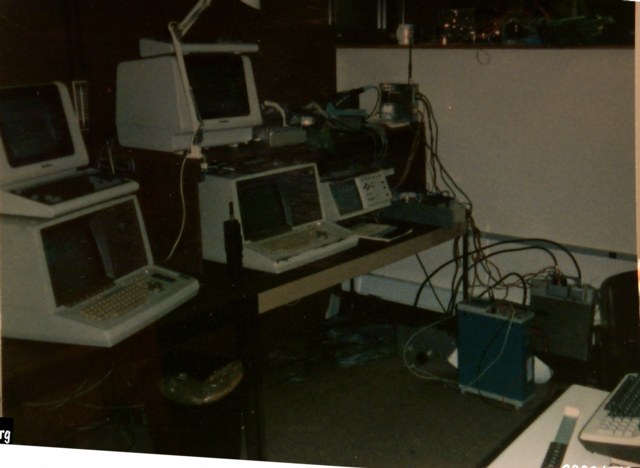
1985
I sold my Apple 2 and my older composite display as well as some radio gear for $1000. With the proceeds I bought a MSDOS 8088 (20MB hard disk hurrah!). I paid $1300 for this and used the amber composite display, later getting a color CGA display. One thing this machine came with which I did not have with the Apple was books. It had a pair of rather generic books on MSDOS and IBM-clones in general. This machine did not come with BASIC-in-ROM as the original IBM-PC did although it had the EPROM sockets on the board for it.
Mostly I played games on this. I had enough programming projects with the repeater controllers (on the HP64000s) and what I was doing at work. I had flight simulator, Wizardry, and several arcade games..
The best word processing/page layout this would do was with a fixed width font and a dot-matrix printer. I picked up a Panasonic 1080i printer for $150 I think. I bought a word processing program called "Professional Write" I think. It let you select fonts but didn't show you any difference on the screen. I did very few text documents and very little modem communications.
early 1987
I sold the 8088 machine, monitor, and printer to my Dad. I don't remember the figure I sold it for.
I moved from PA to Nashua NH - started working in Waltham MA
March 1987
My job has me writing assembly language for 8085 processors to do stepper motor control for an automated blood and urine test system at Nova Biomedical. My product is actually sold to Abbot Pharmaceutical who puts it inside their own machine. The project I was working on had been 'completed' before I started at the company and I was upgrading it for some subtle improvements. At the same time I was migrating the project from a PDP-11 environment to a MSDOS/Novell Netware environment. We would be using Brief by Underware and Avocet assembler.
March 1987
MSDOS 80286-10Mhz/1MB/30MB monochrome display. I bought this computer for $1100 from Flying Purple Fish which was a garage (and living room) company in Revere Mass. I wrote a bit of C code (using Borland tools) and used the computer on packet radio.
August 1987
I moved from south to north Nashua and also changed jobs. Now working in Merricmack NH. My roommate had a MacSE and laser printer.
Sept 1987
I put the 80286 onto packet radio as a BBS, moving radios around to make a small packet network so my BBS could talk to other BBSs in the area from my valley location. I'd changed jobs again and now was getting enough new code development in at work and wasn't missing the Borland tools.
1988
At work I bought 3 HPUX workstations, replacing the 2 HP64000 stations we'd had before. The four software engineers used these as well as a pair of HP Vectra 80286 MSDOS machines. I had to learn Unix as I was supposed to be the system administrator for the HP UX network. I dabbled a bit and wrote C code for the Unix boxes as well as my normal job of writing in 68xx and z80 assembler for the company's embedded processor products. They also picked up a bunch of Mac IIs, a few Apple laser printers and a Localtalk network run all around the office building.
1988
I sold the 80286 and started using dumb terminals for packet radio. One of the other local hams had put a BBS up on packet and It seemed that a $1000 computer was a waste on a redundant BBS. I was more and more doing imbedded processor stuff with work tools. Also, my roommate's MacSE was better for everything I would do at home than the MSDOS machine was. I had PageMaker on his SE, as well as Cricket Draw and MacPaint. He also had a laser printer which was stunning compared to the dot-matrix printers I was used to.
I started mapping the local packet installations and publishing a free newsletter to the regional packet community.
Sept 1989
The North East Digital Association was born. I'd tried to suggest to the New England Packet Radio Association that I would publish a newsletter and that the group should promote the creation of a packet network. They would have none of it so I worked with several other people from all over NY, MA and NH to start our own new club. We NEDA network!
I bought a house in Milford NH fully intending to spend the rest of my life there, in a care-free bachelor existence.
1990
I wanted to buy another computer. On discussing it with my brother, he strongly recommended that I get a Sun workstation because of it's high end OS, built in communications software, and other issues. I was a little afraid of the lack of compatibility with MSDOS software (that I already had, and that I could get through sources) and I didn't like the idea of taking my hands off of the keyboard to use a mouse (I'm a accellent typiest even if I cant spel). So... I bought another 80286 machine for $1000 from a friend of a friend. He actually rented it to me with the understanding that if I paid $1000 I'd get to keep it. This one was an 80286-16Mhz/1/40MB. I turns out I only kept it for a few months because....
I lost my job, lost my house and went back to college at
Clarkson in northern NY. The house was still in my name but
a friend was paying the full mortgage and I promised to sell
the house to him when he could arrange financing. Eventually
we did this.
The economy was pretty terrible in the north east. The reason
that I gave up the house was that the job market and real estate
market were terrible. i could have kept the house and moved
someplace else but paying the mortgage on the house was a nasty
business if I wasn't going to be living there. It didn't
look like I'd be moving back for years and by that time I would
have lost more on payments than I had into the house. As it
stood I only lost the equivalent of 18 or so mortgage payments and
maintained my credit rating.
I went back to school because I figured that if I was going to be
unemployed I might as well be profitably unemployed. Besides that
having the time to go back full-time was a pretty good luxury. I
was hoping to finish a BS and take advantage of the education
and my previous 9 years in the computer industry.
Sept 1990
Clarkson insisted that we had Zenith 286 PCs. They charged us something like $2800 over 4 years for a machine with 640K of RAM and a single 1.2MB floppy. I bought a 40MB Seagate 251 hard drive for $300. $8.25/megabyte
Even in 1990 it was considered ridiculous to have a MSDOS machine without a hard drive but the university didn't seem to have noticed. I think universities work on kickbacks from corporations and didn't really put much though in how good it was for the students. I wonder if the fact that Clarkson had Zenith Unix boxes in the computer machine room was a clue.
Oct 1990
I bought a MacPlus/4MB & 40MB HD (actually concurrent with the
Suns) -- I bought this used from a listing on an Internet newsgroup
for something like $1100
In order to print I would log into the school's computers using a
1200 baud external modem and then send the PostScript file via
Kermit (packet sending protocol). Then I'd go to one of the
computer centers on campus and print the postscript file from
the school computer onto a laser printer. Where-as the transfer and
walk to campus part was
exceedingly slow, the school laser printer was fast and
once I was there I could actually make several copies if need be.
Nov 1990
MSWindows was around by now. I bought a used copy of PageMaker for MSWindows. It came with MSWindows. It didn't work worth a damn. All of our school tools (Borland C++ etc..) ran in MSDOS so it wasn't an issue. I was using the MacPlus to do my writing homework and to publish the NEDA newsletter.
During the winter break of my first year back at Clarkson. the night of Dec 24th(!) the house I was renting with four other students burned down. I lost my stereo, TV, clothes, record albums (LPs), music CDs, floppies, water bed. Much of my stuff was in storage in New Hampshire so it was by no means a total loss. My textbooks and the Clarkson computer were saved by being on my workbench and when the ceiling in my bedroom collapsed the workbench bore the weight. Thus the computer and books were protected. The floppies would have been too except that the landlord went through the house grabbing the computers that were salvageable, and my floppies which were on top of the computer ended up floating (then frozen) in my waterbed.
It gets worse.. The week before my house burned down, I was working as a tech writing consultant temp in Rochester NY (using my Mac Plus) during winter break, my hard disk died and I trashed it trying to fix it. I knew I had backups up at the house in Potsdam. I left Rochester on Dec 23rd (we had the 24th and 25th off) to go to Potsdam to get my floppies.
My car died from a problem that the model (1988 Acura Integra) was eventually recalled for and stranded me near Watertown NY. I was put up for a night by a ham I knew from NEDA and then took a bus on the morning of the 24th to Massachusetts where my parents were living, arriving about an hour before the news that the house burned down. I never made it to the house and never got my floppies. On Dec 26th my dad drove me back to Watertown and Potsdam to get my now-fixed car (it was towed to Honda in Watertown) and inspect the wreck of the house.
1991
I bought a 30MB external SCSI drive to replace the broken one for $299. That cost me about $10 a Megabyte but was in an external SCSI enclosure.
Here is a photo taken in the new house in Colton NY. Notice the Zenith PC, the MacPlus. This is on my newly built workbench. The one that the house burned down around was resurrected and installed in a public area of the house.
Pardon the crappy photo but it's much better than NO
photo!
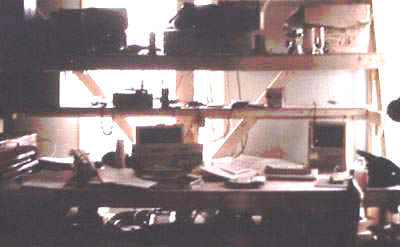
Jan 1991
My roommates and I bought computers. I got a Sun 2 with
SunView?
Matt found a deal from the University of Ohio, I think, that
involved a Sun2 computer with 8MB of RAM, an optical mouse, a 19"
monochrome monitor, and no HD. As I recall they comptuers were
$250 each plus about $80 shipping. They were heavy and ran hot,
loud and drew several hundred watts. We bought two. He also picked
up a tape drive someplace.
We bought a Micropolis 330MB SCSI drive used for $800
from some surplus house. I owned one of the Suns and half of the HD.
Matt was already a unix administration guru and was looking
for another challenge so I helped by buying one of the
workstations.
The Micropollis HD cost us about $2.42 per megabyte.
Networking is born. 10base2 between 80286 PC and the Suns.
July 1991
I had some insurance money because I still had homeowners coverage from the house in NH. I talked with my brother regarding computers. He was now doing MacOS stuff. He arranged that I could get a developer discount on a Mac. I bought a Mac2Si/3MB/40MB for $1800 with developer discount, a QMS 410 postscript laser printer (300dpi, 4PPM) for $1880, a 14" Sony CPD-1304 SVGA multisynch monitor, and for $550 I got an additional 16MB of RAM.
Dec 1991
I moved to Lynnwood Washington to form startup company based on SCSI HD RAID systems.
Dec 1991
Before the move I sold off my Sun, kept a 330MB HD sold Mac Plus. Down to one machine now. My housemates had a MacSE, a MacII with Radius Rocket, and a 80386 based EISA machine. I used the 80386 and my 2si for development work. We had a localtalk network between the Macs and two laser printers.
Jun 1991
While I was in Washington the job of NEDA newsletter editor fell on a member who is also a close friend. He didn't have a laser printer so the club bought it's own NEC Silentwriter 95 postscript 300dpi laser printer. (this is important in a few paragraphs)
Nov 1992
I moved to Hackensack NJ having fallen on face with startup - most of the people involved eventually started conflux.net
The new company is Eventide. Initially my job is to participate in user interface design for the company's DSP4000 and to write it's operator's manual. I was to use a Gateway 486PC. I requested a laser printer and large display. Since I knew about the Silenwriter 95 I requested one of those. I was using Pagemaker, Freehand and other familiar tools from my Mac days.
Feb 1993
After I returned to the east coast I helped a bit with the
newsletter, and did the Annual for the club. Eventually I
did a few issues on my own again. When I got the newsletter
job back I was given the Silentwriter 95 from the club to use.
I made a deal with my friend that he'd get my QMS
410, I received some compensation and an HP inkjet printer
which my Dad ended up with.
| This is me at the Patterson New Jersey packet network site. | |
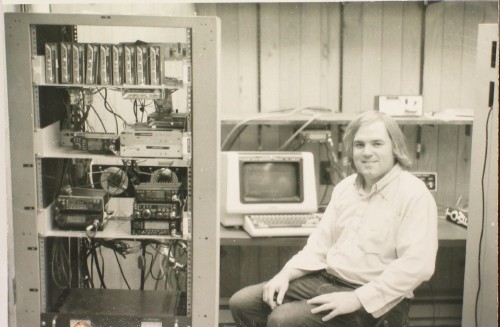
|
The top two shelves of the rack has a set of twelve smart modems, each of which served as a network switch, at 1200 or 9600 baud. The second and third shelf have several VHF or UHF 2-way radios. |
May 1993
I had a problem with the power supply fan on my external 330MB hard disk box. My simple diagnosis suggested that it was time to buy a new SCSI 500MB hard drive. It cost $600. For a while I put it in the same enclosure that the 330MB hard drive was in. The 330MB hard drive is 5.25" wide and 3.5" high. The new 540MB is 3.5" wide and 0.7" high. It was small enough to fit in place of the 40MB inside the Mac 2si. As soon as I realized that the problem was the power supply fan I put the 500 inside the 2si and resurrected the 330. Now I had 870MB of HD. Golly. Such vast expanse!
My brother sent me a 19" SuperMac monitor and video card for my birthday. These were show surplus. Great gift. I now have a great monitor. It does 1024x768.
I hooked both the Sony 14" and the Supermac 19" to my 2Si.
Nov 1993
I resigned from the job of NEDA Quarterly editor. I was getting very tired of spending all sorts of time on that and wanted to do some hardware work. I was still committed to doing one more issue of the Annual.
Feb 1994
I started dating Nancy and loaned her and her daughter an old Mac II with my Sony monitor.
Jul 1994
Here is a photo of my apartment's computer desk with just
the SuperMac monitor. This was taken shortly after the last
version of the NEDA Annual was published. You can see the
Mac2Si on the shelf right to the upper left of the cat
(Cornelius). The NEC laser printer is on the far right of
the bench. Just to the left of it is the external hard disk
case with the 330MB Micropolis drive. To the left of that is
a pile of ham radio equipment.
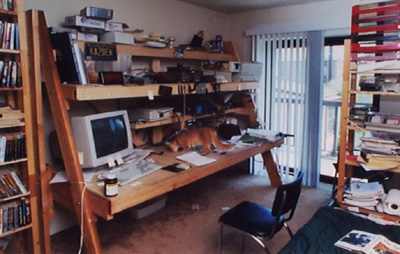
Sept 1994
I bought Nancy an Apple Powerbook Duo 230 for her birthday. I got it surplus from the User Group Connection for $800. The Duo lacks i/o but is very light and thin. Its only i/o is a RS485 serial port which can serve as an RS232 connection, or network connection. I had to install applications and whatever over the localtalk network.
Dec 1994
I married Nancy and moved to Mahopac NY.
Dec 1994
Set up Localtalk networking between Laura's MacII and the 2Si.
Dec 1994
Bought Laura a CDROM drive. This was our first CDROM drive. It cost $300 for a 2x drive.
Mar 1995
We bought a Performa 6116CD/8M/250MB/2X $1300(factory refurbished) (first PPP connection - first access to a web browser - first web page came days later on a computer at Clarkson college). Laura got the Mac2Si which suffered from intermittent audio. I made an external SCSI box for the 330MB HD and the 540MB HD out of a mini-tower PC case. We picked up the duo-dock for the laptop. Now we can hook up the duo with the Sony monitor if we want to install software. The dock cost about $200 as I recall.
July 1995
Somebody in NEDA who took the editor job needed the laser
printer so that went away. We bought an Epson Stylus Color
II inkjet printer with localtalk/appletalk for around
$600.
We bought an Iomega SCSI Zip drive for about $150.
1996 was a major year because we moved back to NH and I'm now working out of a nearby office that I rent. Eventide lends me computer gear. To start with I had a Pentium 66/MSWindows3.11, dual 500M drives, CD, 20MB, no networking, no modem and the old Silentwriter 95.
July 1996
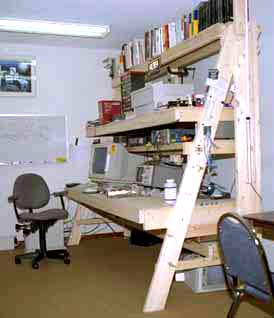 I
rented an office a few miles from home and built a new bench
to hold the computer gear. The Pentium 66 with MSWindows3.11
For Workgroups is behind the chair. NEC laser printer on
upper shelf. The monitor is a Mitsubishi. The bench won't
look this way for long. Generally I have some dissected
hardware project spread across the bench. At this time I'm
working on an audio device that incorporates a 68000 series
processor and a 56000 series DSP. I'm doing the software for
both processors as well as for a 68HC75J1A single chip
computer. I do very little prototyping for my employer but
for this project I had to build the prototype for the front
panel of the device. I was designing the communications link
and only had eight 28 gauge wires to carry the power for
several 7 segment displays, do reset, and communications so
I was trying to save wires by doing things in a tricky
manner.
I
rented an office a few miles from home and built a new bench
to hold the computer gear. The Pentium 66 with MSWindows3.11
For Workgroups is behind the chair. NEC laser printer on
upper shelf. The monitor is a Mitsubishi. The bench won't
look this way for long. Generally I have some dissected
hardware project spread across the bench. At this time I'm
working on an audio device that incorporates a 68000 series
processor and a 56000 series DSP. I'm doing the software for
both processors as well as for a 68HC75J1A single chip
computer. I do very little prototyping for my employer but
for this project I had to build the prototype for the front
panel of the device. I was designing the communications link
and only had eight 28 gauge wires to carry the power for
several 7 segment displays, do reset, and communications so
I was trying to save wires by doing things in a tricky
manner.
Sept 1996
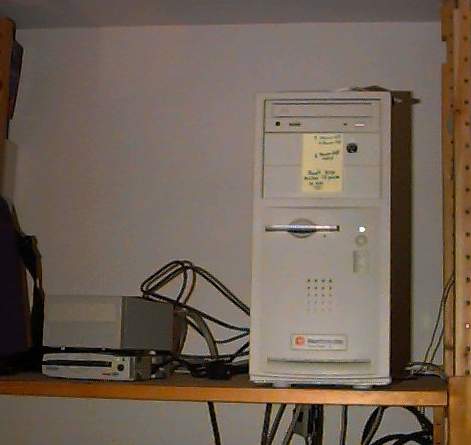
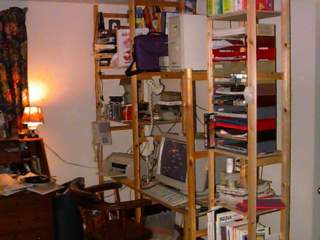
We bought a Power Computing 604/180Mhz/1GB/16MB/500M
$2500(factory refurbished) from the User Group Connection. I
paid an additional $300 for 32MB upgrade. Now we had two
Macs with 10baseT capability. - 10baseT attempted, gave up.
The problem here is that MacOS doesn't let you have two
network ports enabled at once. If I wanted access to the
printers and non Ethernet computers I couldn't have access
to the Ethernet. I really needed a Ethernet to Localtalk
bridge but didn't get one for another year. The top photo
shows our new computer with the zip drive and an external
hard drive case holding a 540MB hard drive. There is a
switch mounted in an unused drive bay on the front of the
PowerTower box. It has a yellow post-it note next to it.
This switch turns on the power to one of the two internal
SCSI drives. If the power is applied during boot, the
PowerTower will boot from my system folder. If power is not
applied, it boots from Nancy's. This way we turn a Mac into
a dual user system.
The lower photo shows our shelving that held the computer
gear.
Laura got the Performa 6116
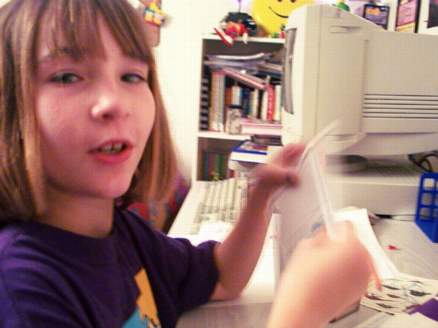
Oct 1996
Nancy's going to have a baby!! Nancy's going to have a baby!!!
Oct 1996
My employer decided to venture into Mac software for an
audio project. We got a Power Computing Power Tower Pro 210.
This machine cost about $3000 and had 2GB, 64MB and a 210
Mhz PPC 604e micro with lots of L2 cache on the
motherboard.
This picture shows me and the computer. All of the equipment
in the photo is my employer's. There is a Mitsubishi 21"
monitor and the Power Computing 17". Both monitors are
hooked up to the PowerTower. Yes the Mitsubishi is
quite a lot dimmer than the Power Computing monitor. Up to
the right is the NEC Silentwriter 95 printer (my employer
and NEDA own the same printer.) The Pentium 66 is on the
floor behind my chair but isn't hooked to a monitor right
now. I switch it into the Mitsubishi but since I don't need
to run the tools that are specific to MSWindows 3.1 I don't
use it very often.
The workbench is one that I built.
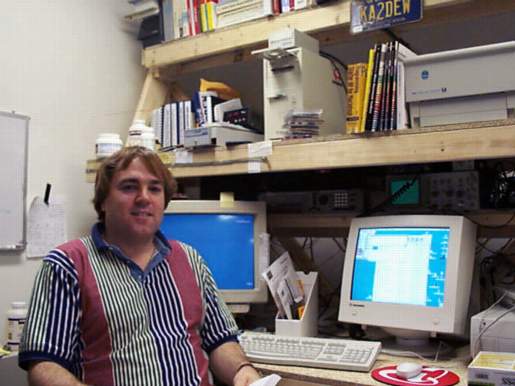
Dec 1996
My wife's employer Lyndeborough School District, lent us an Apple Quicktake 150. This camera costs about $700 I think and took 16 640x480 photos to store in it's 1MB of FLASH memory. Nancy and I decided that we have to get one of these before the baby is born.
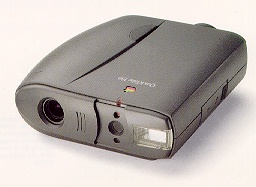
May 1997
Father's day I got a Kodak DC120 one megapixel digital camera! It cost about $1200, takes 1280x960 images (although they are interpolated up from 1 megapixel) with excellent color balance although the images don't really look very good under close inspection due to noise. After reducing to 640x480 they look very good though.
The camera shoots rather slowly. it takes a half a second for the picture to actually "take" and then the camera is stuck for about 20 seconds processing the image and storing it to flash. The camera has 2Megabytes of flash memory for photos built in and a slot for a CompactFlash card.
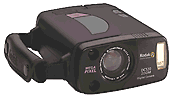
May 1997
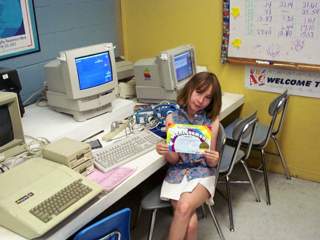
I went to Laura's school for an open house day. I visited
Laura in the computer room at her school (among other
things) and took these pictures.
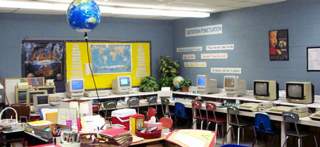
Click on this picture for a larger version.
May 1997
Nancy
went into premature labor! The doctor says she has to stay
off her feet until the end of June! That's 8 weeks. I set up
an entertainment and communications shelf next to the bed,
hired a 2 hour/week maid service to keep the other life
forms in the house from evolving too fast, and started
working in 3 hour gulps.
The picture includes Nancy, the 19" SuperMac monitor, an
Icom 146Mhz ham rig, an Iomega Zip drive, an Epson Stylus
Writer 2 printer, the PowerTower 180, a Kenwood 711 146Mhz
ham rig.
Nancy hadn't had time to really play with the Internet before. When we were in Mahopac our network connection didn't work very well. Once we were in NH Nancy got a job teaching and didn't really have the time to sit back and relax with the web browser and whatnot. This was a real eye opening experience. She found out about chat rooms, search engines, corporate and personal web sites showing off product info and whatnot. She came away from this with a real respect for the power of the www.
May 1997
We I bought a 10MB compact flash card from PC Connection for $249 (no shipping) for the DC120 camera
June 1997
Nancy had a baby. John Anthony Torborg, aka Jack. No more money for computers. (the Power Computing was the last computer we got that cost more than $1300 until Nancy started working again -- the previous several machines were somewhat more expensive than that!).
Laura is off to a boarding summer camp. We thought that this would both be good for her socially, physically, and especially mentally since Mom wouldn't have much time for her during the first month or two with Jack at home.
Aug 1997
MacWorld Expo - Boston. We won exhibit-only tickets on
WRKO, a Boston radio station the day before the expo. I had
only an hour and a half to drive down to the station to get
the tickets. Now that we've been to a show we'll definitely
make the next MacWorld Expo that comes to Boston. Nancy took
the photo. Laura was away at summer camp.
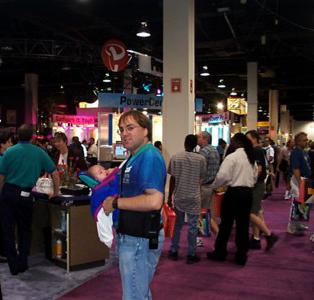
I picked up a free version of BeOS at the trade show. It
installed on the Power Tower 180. Very nice operating
system. There weren't a huge number of 3rd party
freeware/shareware packages for it but the stuff that Be has
already was very nice and the OS is extremely efficient
compared to MacOS 7.5. I created a hard drive partition that
has BeOS and will switch to it once in a while. I don't
think I'll make it my 'home' operating environment yet.
Sept 1997
I acquired parts at a computer show and home assembled a Tyan motherboard based Pentium 233/64MB/4GB with MSWindowsNT4 - $1000 (mostly from selling off my collection of repeater gear and 220Mhz radios. Got Windows NT4 as a gift. - 10baseT works. Internet is still individual dial-up modem based. I got a localtalk to Ethernet bridge at a flea market for $25. Now my daughter can get to our printer in the bedroom from her computer and we have reasonable file transfer speeds. I'm using FTP and a trivial FTP server program that I start up on the Macs to go between the Wintel and the Macs.
Oct 1997
I ended up bringing the P233 to my office in place of my employers' P66. At the time I needed to be back on an old project using MSWindows based tools. There was no budget for a new computer. The P66 has MSWindows3.1 on it and only 12MB of RAM still. The PowerTower 210 is still there.
Dec 1997
I acquired torborg.com domain - now using conflux.net in Everett Washington for web pages.
Jan 1998
Here's Laura and Jack playing KeyWhack on the
PowerTower.
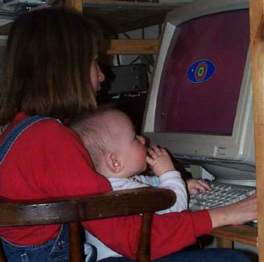
April 1998
The project I was working on for my employer with the Mac ended. I had to give up the PowerTower 210. They upgraded my MSWindows3.11/P66 computer with a Pentium II-300/64MB/6GB/MSWindowsNT4. For a while I had been using my own Pentium 233 because it was so much faster than the P66.
May 1998
I built a bench at home to hold the Pentium 233 and
PowerTower such that Nancy and I could both use our
computers at the same time.
This photo is of our computer bench. The SuperMac monitor is
under the PowerTower 180. The Sony monitor I got in 1991 is
next to the Pentium. Above the Pentium is the Duo dock which
we would use on the Sony monitor and with the keyboard
borrowed from the Power Tower. Just to the right of the
window is a 146Mhz ham radio and a short wave ham radio.
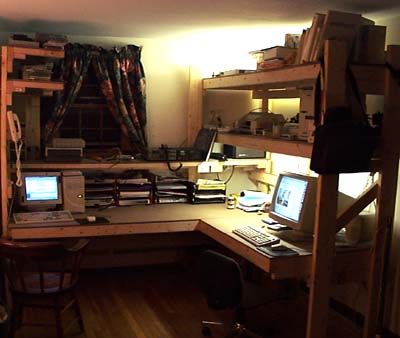
June 1998
I took back the job of NEDA newsletter editor and got back the NEC printer.
Aug 1998
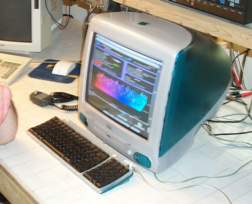 We
bought a bondi 233 iMac for Nancy so I get back my
PowerComputing. Nancy and I have become avid Mac fans. We
paid $1349 for this machine with 96MB of RAM and 4GB HD.
Nancy fell in love with it when it was announced in June and
we had it on order almost immediately. We were at
ComputerTown in Nashua NH on August 15th to pick it up.
We
bought a bondi 233 iMac for Nancy so I get back my
PowerComputing. Nancy and I have become avid Mac fans. We
paid $1349 for this machine with 96MB of RAM and 4GB HD.
Nancy fell in love with it when it was announced in June and
we had it on order almost immediately. We were at
ComputerTown in Nashua NH on August 15th to pick it up.
network: First I tried to use the Power Computing as a router. I was using IPNETROUTER. It was a short term demo and it worked. So, I put it on the old 6100. The 6100 seemed to crash and lock up all of the time. I found IPROUTER which also was available as a demo and ran on an MSDOS PC. I got a used 486sx25 for $25. IPROUTE worked. So I bought the program, made an installation in the basement and got a 56Kbaud phone modem for it. 10baseT is back with a vengeance. I ran cables all throughout the house with wall jacks in the upstairs bedrooms. This is the first time I had internet up for more than several hours at a time. We're now on line most of the time with internet on 3 Macs and 2 PCs. Laura got the Power Computing.
Nov 1998
My sister-in-law Susan bought an Apple Applevision 1710 17" monitor to use in her home office. It was back in the Apple shop twice before it finally stopped working altogether. Susan handed it over to me and asked me to take care of it since I had a local Apple repair shop. The local guys got Apple to swap it out. It took a little while. Susan was out of a monitor and it hurt her operation at her office so she ordered a NEC 17" as a backup. When we got the Apple back it still had some problems, especially at higher than 1024x768 resolution. Susan said I could keep it. So I keep it. It sits on my Pentium 233. I lent a friend of mine (Bob) my old venerable Sony 1304 monitor.
Jan 1999
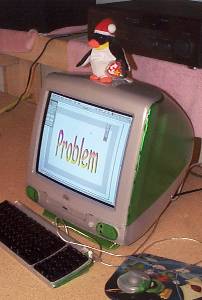 We
bought an iMac266/96MB/6GB $1349 for daughter Laura (we
wouldn't have done this except for a few details. She
started lusting after Nancy's iMac as soon as we ordered it.
I had a picture of it as my wallpaper on my Pentium 233
(irony there). We told Laura that she could have one only if
she could learn to type 30words per minute.
We
bought an iMac266/96MB/6GB $1349 for daughter Laura (we
wouldn't have done this except for a few details. She
started lusting after Nancy's iMac as soon as we ordered it.
I had a picture of it as my wallpaper on my Pentium 233
(irony there). We told Laura that she could have one only if
she could learn to type 30words per minute.
Well... Laura performed a major miracle with her grades plus
she made major headway on typing, getting past the hump of
having to watch her fingers, AND using the home row... so,
in a moment of weakness...
We got an extra 64MB. I think it cost about $100.
network: We now have 3 good Macs. The 6116 serves Jack as his bang-on-the-keyboard toy (he actually can play many made-for-a 4-year-old video games and talking books). The 6116 is also our token floppy-disk-drive equipped Mac and runs System 7.5.5 to be compatible with some of the old software.
Our network is now 10baseT with several hubs. We have Nancy's iMac, my Pentium233, Jack's 6116 and two printers in the master bedroom. The router is in the basement. Laura has her lime iMac 266 in her room. The Power Computing currently resides in the dining room as an auxiliary computer. Once in a while it gets used as a guest station for multiplayer gaming, for a typing terminal for homework or projects, or for internet access when company is over or when business is transacted with visitors.
Sept 1999
Nancy started working full time again. She's now a shop teacher specializing in technical education. She has 6 old StarMax MacOS machines in her classroom wired to Media One's Roadrunner broadband modem.
I moved my office to the basement. This means I'm now working somewhat strange hours and usually have to work a bit more than 40 to keep up with everybody's expectations. A major advantage of this is that I now have an internet connection via the house LAN,and separate phone connection. I have a dedicated office phone which costs less than half what I was paying in the office I was renting. I also can have outside antennas which is good because my current project uses antennas.
Oct 1999
We bought a new iMacDV/64/10GB for Nancy. We paid $1299
for this one and then another $235 for 128MB of RAM. We sold
the Bondi iMac to a friend (Bob) for $500. The major reasons
for this purchase were:
3. it was pink,
2. I wanted my friend to have the bondi iMac,
1. CompUSA gave me $800 for my old digital camera (Kodak DC120) after it
became defective (lens got damaged) under extended warranty.
One of the caveats was that I had to spend
it at a CompUSA store. CompUSA overcharges for almost
everything in the store except for Apple CPUs because Apple
CPUs are very consistently priced.
Oct 1999
We picked up MacOS 9. We got it through the online Apple
Store at an educator discount (since Nancy is now a
teacher).
This is decent. It seems more stable that OS 8 was. Also
SimCity2000 runs again. I haven't been able to run that
since 7.5.5. I really like the ability to do Appleshare over
TCP/IP. My friend Bob who now has the bondi iMac233 and I
were playing games mounting disks over the Internet. It's a
little slow with my 56modem (he's on a broadband cable
modem).
Nov 1999
I bought a Kodak DC290 digital camera. It is just about 2 megapixels and takes the same compact flash cards that my old DC120 took. That means that the 2MB, 10MB and 48MB cards will work with the 290 in addition to the 20MB card it came with. This one is USB as well and came with an OS9 compatible program that even makes quicktime movies out of a series of pictures.

Dec 1999
In November Apple started shipping the G4 Sawtooth motherboard based computer in quantity. Nancy wanted me to have a Christmas present. We pretty much went insane. I replaced my P233 as my main computer. We bought the G4-400Mhz/64MB/10GB, no modem, no zip drive, no monitor - the absolute base configuration that didn't have the modem (the modem was $100 extra and we already have our local area network). It cost $1708. For an additional $1000 I bought a Sony G500 21" monitor and for $195 I bought 128MB of RAM (from crucial.com). It came with MacOS 9.
Jan 2000
This is our computer desk now. The iMac and Jack's 6116CD
game machine are on the left. On the right are my Pentium
233 with the Apple AV monitor and the Mac G4 with the Sony
monitor. Other interesting things in this picture are 2 old
146Mhz ham radios, a GE Master II (really old commercial
50Mhz radio), and an Icom 146/440/1200 ham radio. Also there
is the blue LCD display from an Eventide GPS-synched clock,
our Epson printer, and the NEC laser. The white blob in the
window is the GPS antenna. This is a home made bench that is
free-standing and built to fit the space. It's the same
bench that is in the May 1998 picture. It sure filled up
fast!
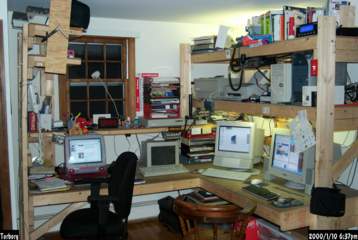
The Powertower 180 is now in the basement in my home-office and serves as our FTP/Apple disk server. It runs seti@home in it's time off processing a SETI@home bock every 48 hours with OS9 and v1.6 of the seti program. The G4 takes between 6 and 9 hours/block.
Jan 2000
Very cool news. Nancy won an iBook on an on-line drawing from SmallDog Electronics.
The computer is pretty fast. It does a SETI block in 15 hours. It's hard drive is pretty loud when spinning and the display isn't viewable with equal clarity from all directions like I thought it would be. If you go up or down relative to the display the contrast changes. Side to side isn't as noticeable.
The case is certainly rugged.
It came with 32MB of RAM and a 3.2GB hard drive. Even
though the hard drive is rather small by current standards
it is big enough for the stuff we'd need to take portable.
The RAM, on the other hand, is pathetically small. Relying
on virtual memory slows it down a huge amount. We ordered a
128MB SODIMM for $180. This will add to the included
32MB.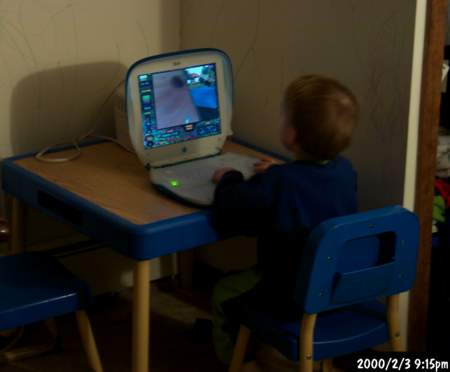
Here is Jack playing Nanosaur on the iBook.
The iBook is the 4th laptop that I've had lots of time to play with. Two of the 4 were my wife's (the other 2 were my mistress') This is the first one that we've gotten when it could still be called state-of-the-art. On the other hand, the other three were all very expensive when they came out.
This one came with software. The others came with just the OS. This one can be opened up to get instant access to RAM expansion - I did it my self in less than a minute - hard drive expansion and probably other things. This one has a 100baseT Ethernet interface with the connector very accessible and rugged on the side of the case. The USB port allowed hot connection of an external keyboard and mouse as well as my CDR writer. With 160MB of RAM this computer is truly powerful even compared with modern desktop machines.
Feb 2000
Now that we have three 100baseT capable computers in the bedroom I bought a $77 Netgear 10/100baseT 6 port hub. I installed it in the bedroom on our bench and hooked it up to the two Macs in the bedroom as well as the iBook (when it is in the bedroom). The speed increase is very noticeable. With the Macs I can transfer about 100Kbytes/second at 10baseT and about 1Mbytes/second at 100baseT.
Jul 2000
Major shakeup. Eventide dumped me.
They said it was a lay off. I think they just got fed up with me out-of-office
7 days a week.
I had to look for another job. I ended up working in Nashua for a local
division of Adaptec
Aug 2000
Adelpha says we can have a cable modem. We ordered it. They gave us an appointment for 3 weeks out. Then the day before the appointment they cancelled and said that it would be 6 months before they started installing them again. The story is that they realized when they started installing the modems that they would need a new head-end and ISP distribution point. They had yet to break ground on it.
Aug 2000
We got tired of waiting for cable modem. Adelphia says they'll have it in Amherst sooner or later but won't make any commitments. I got a Netgear ISDN router and now route through that to Metro2000 ISP. It costs about $45/month for the ISDN service through Verizon and another $30/month for 300 hours/month from Metro2000. ISDN gives us a phone line as well as 56k full duplex to the Internet. One good thing is that it comes up in 3 seconds instead of a minute or so for the phone line. Also, it's hardware and has it's own watchdog and power management. Also takes 15 watts instead of 50 or so.
Oct 2000
I got OS X public beta for the G4. Lovely! Wonderful. No applications but it's lots of fun to play with. I finally have Unix again. Wow. Man does this make a fine network box. There are some weirdnesses with the folders you can share. I ran OS X for about a month before giving up on it. I lost the ability to use the Nikon scanner while running OS X for one thing. I need to find another computer to run the scanner with. Possibly the Powertower 180.
Dec 2000
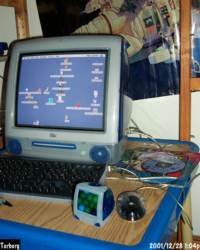 Santa Claus brought Jack a Blue iMac 350 for Christmas. Santa figures
that this will keep Jack from trying to open and close windows on our computer.
Jack has long since become computer literate. At 3 and a half he can even
install his own software. He's frighteningly good at deleting all of the files
on one's desktop.
Santa Claus brought Jack a Blue iMac 350 for Christmas. Santa figures
that this will keep Jack from trying to open and close windows on our computer.
Jack has long since become computer literate. At 3 and a half he can even
install his own software. He's frighteningly good at deleting all of the files
on one's desktop.
Feb 2001
The iBook monitor went away for a week in November and then came back. Now it stopped working altogether. It's out of warranty and will cost big bucks to fix. We haven't put much use in it for a few months so we'll put it aside and not fix it at this time. (we never did get to fixing it and then new models came out that weren't much more expensive than the replacement part!)
Mar 2001
OS X is released! Yay. I installed it on both the G4 and Nancy's strawberry imac. We love it. Alas running Eudora (our favorite e-mail program) and Netscape from classic (which we need to access our on-line bank) is a pain. Classic crashes and things lock up and need to be force-quit sometimes. Nancy says she hates it but will stick with it for a while to learn it. It's much nicer than PB was and there are more apps available. I set up my daughter so she can get to 'her' directory on my G4.
Apr 2001
Nancy got tired of OS X already. Not enough stuff for it. A lack of native versions of Eudora and Netscape were serious bones of contention. We also only have 128MB for her iMac. I have 192MB in the G4.
May 2001
This story is pretty weird. My daughter Laura (who I dote on) and my wife Nancy (ditto)
learned that Laura's favorite crush rock band (NSYNC) was doing a deal to promote Microsoft's
MSN digital network (competitor to AOL-online). If you signed up for MSN, and accessed
a particular web site via MSN, and did it in a certain timeframe, and already held
tickets to a certain concert, you could buy tickets
for a concert (called "the soundcheck") before the concert and be in close quarters
with said rock band.
The problem is that MSN's online service could not be accessed with any computer that
I owned. it needed MSWindows98 or MSWindows2000 running on Intel or AMD hardware.
I asked around and didn't know anybody who had such a computer and OS that wasn't
in a corporate environment where firewalls would prevent MSN from working.
So.. I asked around and did some research and decided that the cheapest way to solve
this in the allotted time was to go build myself an AMD Duron based PC.
A friend of mine decided that he too needed a PC of about the price we were talking about (about $500). We went to a local touring computer show and picked up some computer parts. The Duron 700CPU is $59. Case was $35, 48x Acer CDreader was $29. I got a MSI motherboard (I don't remember why now) for $109, cpu fan for $21 and 128MB of PC133 RAM for $29. The motherboard has built in graphics and sound. I already have a SCSI card and will use my Sony 21" monitor. My wife bought me MS FLight Simulator Pro 2000 so the machine wouldn't useless after we got the NSYNC tickets.
The performance of the machine was much better than my P233 but still not good enough for MS Flight Simulator Pro 2000. The flight simulator is jerky. A-10 Attack (1995 for OS 7.5) is much better on even my old PowerPC 6100. Of course the Microsoft sim has lots of more buildings and real structures in the simulator.
Now that I have the Duron with the SCSI port I can use it for my slide scanner that I used to run on the Mac. Nikon hasn't come out with an OS X compatible driver for the scanner yet.
Jun 2001
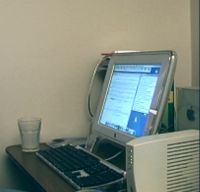 Nancy decided that she wanted OS X again. We put 10.0.3 (I think) on the Strawberry
iMac and upped the memory to 256MB. RAM cost about $40 for 128MB. Now that Eudora
and Netscape 6 are out for X we like it much better.
Nancy decided that she wanted OS X again. We put 10.0.3 (I think) on the Strawberry
iMac and upped the memory to 256MB. RAM cost about $40 for 128MB. Now that Eudora
and Netscape 6 are out for X we like it much better.
We got Nancy a Cube. We paid about $1300 for the cube/450Mhz with 64MB of RAM and 20MB HD. We upgraded it immediately to 256 but had to savage the iMac to do it. More RAM on the way.
We ordered MacOS X server. We'll put it on the pink iMac and make that our house file server. The deal with OS X file sharing is that you can only share the Public directory for the users. You can't have a folder inside of a shared folder that is itself shared to other people. I wanted to create a folder that was read and write shared to several users but not all. It was not easy. OS X server gives me all of those capabilities. We used Nancy's teacher discount with Apple to get the cube and the server software.
July 2001
Apple Stores. Apple has stores. Nancy and I are both pretty amused by the concept. Adaptec had a forced closure for Independence Day week to save money and Nancy and I decide to go to Washington DC. We went to take in the fireworks, the Capital and the Apple Store. While there I discovered that I really really liked digital video.
July 2001
We sold the pink iMac and got back the bondi iMac. The Bondi has been upgraded with a 45GB HD and 256MB of RAM. I put the OS X server on that but I'm having trouble keeping it running. We're also using it as our kitchen computer and perhaps Server isn't all that stable with Omniweb? Dunno.
July 2001
| Still no cable modem. Adelphia says 6 months out still | |
| We got StarBand satellite internet modem and DISH TV network receiver. NASA channel, yay. Also the StarBand now comes with a receiver that does ethernet straight out of the box. I acquired a NetGear RT311 router (costs $80 at Best Buy but I got mine used). The StarBand is pretty high bandwidth compared with ISDN but due to the high latency the FTP upload is pretty slow. This is going to make web page updating rather slow. It was interesting to be able to watch streaming video finally though. | |
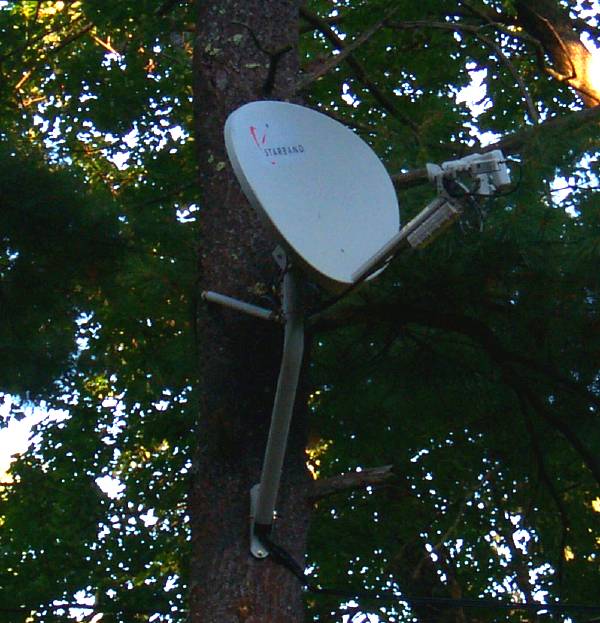
| |
| The StarBand system cost $200 for install and $700 for the gear. Also it's $70 a month for unlimited usage. There is a 1 year contract with a $250 penalty clause. The reason why somebody would be nuts enough to do this is that the ISDN system was costing us more than this every month (figure about $120 a month). Our ISP's ISDN service only included 300 hours a month and all you had to do was leave an instant messenger or e-mail program (automatically checking mail) up and you'd be up 24 hours a day. This adds up fast. Further, the ISP charged a penalty that was a bit higher than the usual by-hour rate. In addition, the ISDN rarely worked at 112Kbaud and usually was 56kbaud full duplex. StarBand was a better deal. If only the cable-modem was available. Adelphia still says it's 6 months out. |
Aug 2001
The StarBand system wants a proxy server to use the fancy http override protocol that StarBand uses. Basically this proxy server program will recognize http requests on the Starband ISP server side and prefetch much of the web page data and send the data to my proxy server in advance of my system requesting it. Thus the monstrous latency inherent in the 44,200 mile path via satellite is partially negated. It only runs on MSWindows. So i need a computer to run it. I decide to go back to the computer show and pick up parts for another computer. This would be a cheaper unit. In the process of talking up the concept I decided to and found market for selling my Duron 700 system and building a more powerful Athlon system. This would be in hopes of getting MSFlight simulator to run without being jerky. I think my total budget for an Athlon 1Ghz system with DDS RAM, an Nvidia GeForce2 MX graphics card, CDreader, 45GB HD, top notch box, and yet another system for a proxy server, this one based on a 500Mhz Celeron system, was about $800. I traded the Duron for some other non-computer equipment, breaking even in my opinion.
I got the Athlon assembled and working and found that it STILL wasn't fast enough for the flight simulator to run smoother. This isn't working well at all. Well, it makes a pretty good proxy server and a dandy Nikon Scanner machine. I left it in the basement with the StarBand modem with it all networked up to the bedroom where the useful machines are.
After a month and a half of trying to make a proxy server using WinProxy (as recommended by StarBand) the machine and the proxy server proved to be too much trouble and so we turned it off. Since MSWindows is so hard to debug I never add or remove software from the Athlon machine and mostly it sits turned off unless I have some film I want to scan
Aug 2001
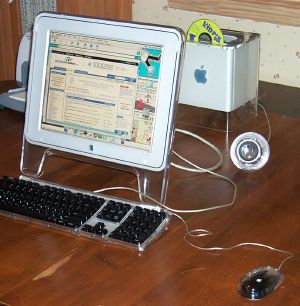 The cube was discontinued, it was my birthday, Circuit City was selling
a cube/450/CDR for $1359. Nancy got it for me for my birthday. It came with
a 20GB IDE HD internal, and 128MB of RAM. We upped the RAM to 512MB for $80. We
bought 512MB of RAM for the other cube as well.
The cube was discontinued, it was my birthday, Circuit City was selling
a cube/450/CDR for $1359. Nancy got it for me for my birthday. It came with
a 20GB IDE HD internal, and 128MB of RAM. We upped the RAM to 512MB for $80. We
bought 512MB of RAM for the other cube as well.
Sep 2001
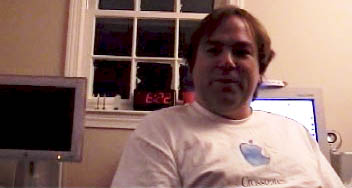
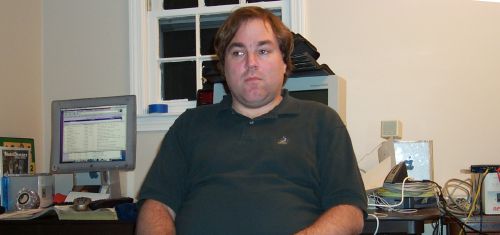
We tore down the bench in our bedroom. We replaced it with a folding table and swear that
we're going to get bedroom furniture class tables or desks real soon.
The folding table now has Nancy's cube and Apple 15" LCD, and my cube
with Sony G500 21" tube.
Nov 2001
Adelphia Cable now offers cable modems on my street! Yippee! Don't I feel stupid now for getting StarBand?
Nov 2001
Laura bought a Sony PC110 digital camcorder (mini DV). (her aunts sent her money) I took care of ordering it and added the extended warranty (the ibook lesson persists) and tested it for a week.
Lots of fun with the camera. I have already decided to get my own (as of last July) the question still is, how nice do I need it to be and when will I do it?
Dec 2001
Laura is coming home for Christmas. She's at a private high school in Rome Georgia. I want her to have the Graphite G4/400 minitower. I set it up with memory and cleaned out the HD and got it all set. She got home for Christmas and wasn't really interested. Argh. I offered that she could work off the cost of it. She wasn't interested. So, it's for sale.
Dec 2001
Adelphia Cable installed the cable modem. Yay!. Cost $60 a month and includes cable TV. I hooked it up with the Netgear router and it works great to all of the computers. We now have two Cubes, the G4/400, a bondi iMac. One of the guys I work with is interested in StarBand and I may sell him the gear and contract.
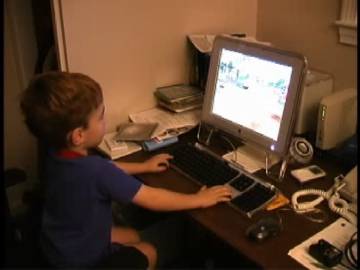
|
Here is jack playing Otto-Matic on Nancy's cube. iPod and cable modem in evidence. |
Dec 2001
For Christmas I bought my wife the discontinued iBook 500. I got it for $900 after
two rebates from PC/Mac Connection. I also bought 256MB SODIMM RAM for it.
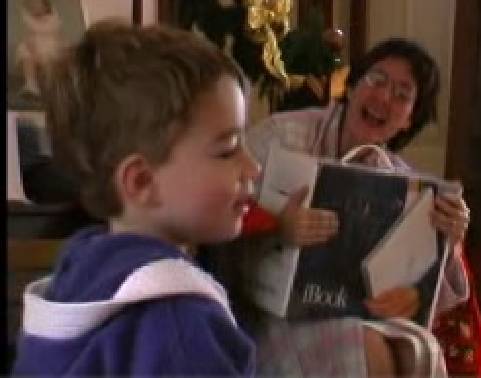
Dec 2001
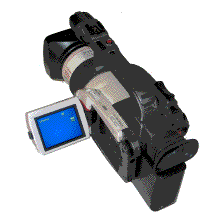 For Christmas my wife got me a Cannon GL1 camcorder. This is great! I immediately
got down to play with it. I actually received it at the beginning of the month. She didn't
know about her iBook until Christmas morning hee hee.
I immediately found out some serious things about using a cube for digital video editing
even with iMovie. First, you need LARGE hard disk capacity. I had 3 Firewire drives
and the cube's internal 20GB. The G4/400 was a much better machine because if it's
multiple HD bays. What I really need is dual internal IDE drives and a RAID MIRROR setup
with the external Firewire drives as a backup. Streaming video at full DV speeds uncompressed
to a firewire drive just doesn't work. I'm considering upgrading the Cube's internal drive
to 80GB. The problem is that the fast drives are too hot. i start using the G4/400 for
video input. Quicktime compression on the cube to the firewire drives is intermittent using
Quicktime pro.
For Christmas my wife got me a Cannon GL1 camcorder. This is great! I immediately
got down to play with it. I actually received it at the beginning of the month. She didn't
know about her iBook until Christmas morning hee hee.
I immediately found out some serious things about using a cube for digital video editing
even with iMovie. First, you need LARGE hard disk capacity. I had 3 Firewire drives
and the cube's internal 20GB. The G4/400 was a much better machine because if it's
multiple HD bays. What I really need is dual internal IDE drives and a RAID MIRROR setup
with the external Firewire drives as a backup. Streaming video at full DV speeds uncompressed
to a firewire drive just doesn't work. I'm considering upgrading the Cube's internal drive
to 80GB. The problem is that the fast drives are too hot. i start using the G4/400 for
video input. Quicktime compression on the cube to the firewire drives is intermittent using
Quicktime pro.
Jan 2002
Apple announced a new iMac. This one has a 15" flat panel on a chrome adjustable tilt swivel pan neck. We saw it the night before the MacWorld Expo keynote where it was to be announced. It is twice as fast as the cube and has DVD record capability. We decided to sell Nancy's cube and get one of these for her. We ordered it during the keynote address on Jan 7 that announced it. The person who took the call at Apple's telephone store said that it wasn't available but, wait, it became available while Nancy was on the phone. It cost around $2000 including a 3 year telephone and repair service contract.
The iMac arrived Jan 30.
Jan 2002
I sold my G4/400 to a friend in Florida for $700. That was $100 less than the price I saw one go for on eBay so I figured it was just about right.
Jan 2002
We bought a dual 1Ghz Quicksilver from the on-line Apple store. We got the stripped down one with minimum compliment that the model came with. It cost $2900 and would be shipped in a couple of days. We also ordered a pair of 100GB drives from a2zcomp.com for $244 each. These are Maxtor 5400rpm EIDE 3.5"LP drives.
Feb 2002
I sold the DVD cube for $760 including 512MB of RAM. So we lost $650 on it in 7 months. That wasn't the BEST deal we'd ever made. We're pretty sure we'll keep the 2nd cube and either loan it out to a relative or a close friend. I will probably laugh about this in a few years because all home computers will be fan-less 8" cubic or less. Hmm??
Feb 2002
Well.. this has been a very Mac season. We have 3 new Macs and a camcorder and have
been to half a dozen Apple store openings and a keynote telecast. Wild. I better make
use of these DVD recorders! I made 3 home-movie DVDs before the end of January. The last one was
a pretty neat production.
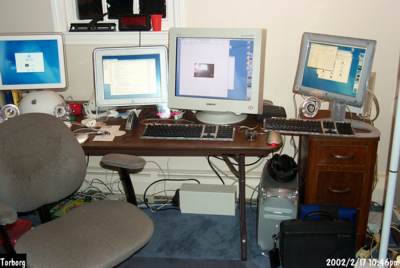
Mar 2002
Interesting things this winter include using Eudora e-mail client to filter
SPAM e-mail. My system is based on the idea that if I don't know the sender I
kick the message back to the sender asking them to do something specific in
the subject line that proves that they are not a SPAMMER.
Apr 2002
I ordered RAM for Nancy's G4 iMac. 256MB SODIMM for $104 from Crucial. That's not
a great price for 246MB but SODIMM isn't the cheapest form factor at this time either.
PC133 DIMM is probably the most common. 512MB PC133 DIMMs have been as low as $90 but
right now are more like $130 or so.
May 2002
I sold the 2nd cube. We got $1100 for it including 512MB of RAM. This was a CDRW unit.
Jun 2002
I've been told that I've been laid off again. Alternatively I can take a transfer to Orlando Florida.
Jul 2002
We decided to fix up our house and sell it and then move to Florida. We have a deposit on a house
that will be semi-custom in new construction about 25 miles north east of Orlando.
Aug 2002
We have moved. I'm still working on
RAID cards for PCI bus computers as a firmware engineer. We're selling our house and
hopefully buying one in Orlando area.
Aug 2002
In the mean time we are renting an
apartment with Time-Warner cable modem. My 21" monitor is in storage. In the
apartment we have a tadd-bench with Nancy's iMac and my G4/dual-1ghz. I have
the two 15" flat panels on the desk but so far only one digital video output
from the G4.
mostly I'm doing video and image management, paying bills, and
internet user stuff. No real big
projects. Apple store opening in October here in Orlando we understand.
Sep 2002
Nancy got a job at the Apple store! Store opens in a few weeks and
she'll be working part time as a salesman. She's learning Apple's methods
of running a store at school on weekends and spending an hour or 3 each
day studying up on hardware, software, configuration and other topics
around Apple computers.
Oct 2002
I ordered 3 computer things this month. I got a 512MB PC133 RAM for Jack's iMac for $75 delivered by fed-ex from Crucial. I ordered an ATA133 PCI card for the Quicksilver for $99 and a Radion 7000 graphics card that plugs into PCI and generates DVI video and SVGA video, for my Quicksilver, for $125. The ATA card will let me increase the internal IDE hard disk complement of the Quicksilver from 2 to up to 6 (although there needs to be another bracket or something to go over 4).
I made a movie of the Millenia Mall Apple store opening and posted it on the web. Our cable modem is working well with 2Mega-bits-per-second in bound and 500kilobits-per-second outbound. Life is good. My DC290 digital camera is showing signs of age though. The flash is not working reliably. 3 years and 16,000 pictures so far.
Here is a photo of our desk in the apartment during this period.
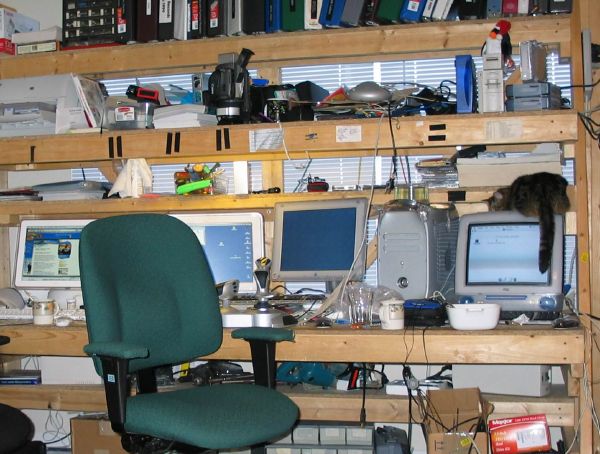
Oct 2002
It looks like we're buying a house in Orlando having sold our house in NH.
It will be constructed over the next year.
I'm getting CAT5e wire in (they can't do Cat 6 yet and it didn't seem worth pushing
for) all the bedrooms, the living room, kitchen, and family room. Hopefully
they have cable modem and DSL (the neighbors say they do). It appears they have
Adelphia Cable?? Adelphia is having major fiscal problems recently. DSL is very common
in this area too.
Nov 2002
I picked up a 200GB hard drive from Maxtor for the Quicksilver. It cost $313 after rebates and including a 2 year full-refund warranty from CompUSA.
I made a movie of the Space Shuttle STS113 launching at night and posted it on the web. The movie is 720x480 and takes about 12MB compressed at 3 minutes. It's 665MB uncompressed. link to movie.
Dec 2002
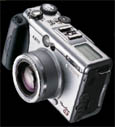 For Christmas Nancy is getting me a Cannon G3, 4Megapixel camera. Takes pictures almost as fast as I can
push the trigger. Makes 15 frame per second movies at 320x240. Stores in JPEG. It also has a "RAW"
format that allows saving the image and then doing post-processing on it later, in the camera, before saving
the image in jpeg. This includes doing white balance setting by shooting a white piece of paper under
the same light the image was taken on. Pretty cool. $850.
For Christmas Nancy is getting me a Cannon G3, 4Megapixel camera. Takes pictures almost as fast as I can
push the trigger. Makes 15 frame per second movies at 320x240. Stores in JPEG. It also has a "RAW"
format that allows saving the image and then doing post-processing on it later, in the camera, before saving
the image in jpeg. This includes doing white balance setting by shooting a white piece of paper under
the same light the image was taken on. Pretty cool. $850.
Feb 2003
June 2003
July 2003
I've been backing up my data onto DVDs recently. They are down to $3 each for 4.3GB of data from Apple. $2.30 or so from other vendors.
July 2003
August 2003
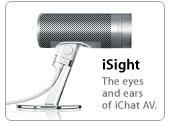 I bought an iSight camera. This is easier to use than the camcorder and I was
very curious about how well it worked. It seems very adequate. Light sensitivity
isn't as good as the camcorder but the quality doesn't deteriorate, only the color balance,
as the light gets dimmer. Things get green. The camera is much lighter than I expected. The
mounting brackets and cable assembly are beautiful. Very elegant.
I bought an iSight camera. This is easier to use than the camcorder and I was
very curious about how well it worked. It seems very adequate. Light sensitivity
isn't as good as the camcorder but the quality doesn't deteriorate, only the color balance,
as the light gets dimmer. Things get green. The camera is much lighter than I expected. The
mounting brackets and cable assembly are beautiful. Very elegant.
Edit: After owning one of these for 8 months I've decided that it is a fantastic device when coupled with iChat as the video quality that the iSight is capable of is taken advantage of with iChat. I used the iSight on several other chat devices which could not use 15 frames a second or could not do 640x480. Apple has another win for me but it probably won't sell well into any other markets.
August 2003
September 2003
October 2003
I also picked up another iSight for Nancy's computer.
The house is still 5 weeks away.
October 2003
The house is still 5 weeks away.
November 2003
November 2003
December 2003
December 2003
220KBytes/second with an on-line test web page
60KB/sec download speed from my web server
31KBytes/sec TO my web server.
December 2003
December 2003
January 2004
January 2004
January 2004
February 2004
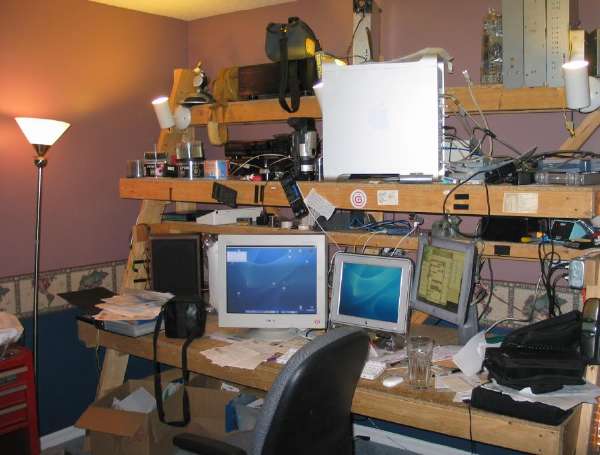
The three monitors are on the G5. The two LCD displays are connected to the ATI Radeon 9600 AGP card and the Sony G500 is connected to a PCI ATI 7000 card.
My external hard drive pile is to the right of the G5 all the way to the right edge of the picture. On the shelf above the G5 are, from left to right, a ThrustMaster joystick/USB, an aging camera bag for my little used SLR, a 13 year old Yamaha "natural sound" stereo amp with camcorder bag on top, a grey sheet-metal box that houses my first ham radio packet digipeater automated network device (based on a TAPR TNC-1), a Kenwood 2m all-mode radio that i used in the 80s to work JAZ-1 satellite and used for weak signal VHF SSB as KA2DEW, three rack panels on edge that are each ham radio repeater components (2 repeater controlers and a 220Mhz repeater) that I built in the 80s and finally a cast aluminum enclosure holding a 2m synthesized HT (Tempo S1) that I remoted the control logic to connectors for radio remote control operation.
There is practically too much stuff here to discuss. One of the items on the desk level (where the white keyboard and mouse are) is a functional and hooked up 30 year old dial telephone. Can you spot it? Hint, it isn't anywhere near the nearly-hidden PowerMac G4 and it isn't out of the picture to the right like the Right-channel EPI bookshelf speaker.
April 2004
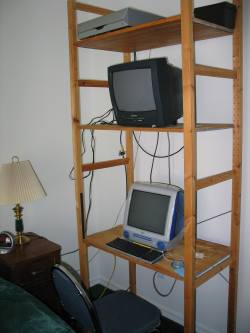
April 2004
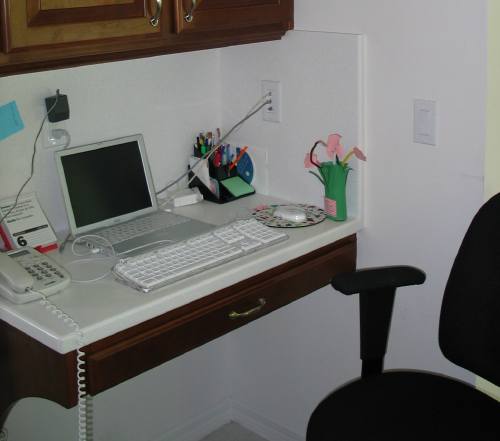
May 3, 2004
On ebay I aquired two more FE104 Netgear 100baseT hubs for about $25 each including shipping. I use these along with the original one I had to allow me to put 2 or more computers in each room. I needed this first to put the TiVo on the same jack as my wife's computer and to hook up the iMac farm in the family room.
May 20, 2004
We are planning on keeping our Bellsouth line but disconnecting ATT.
June, 2004
June, 2004
August, 2004
Doing the math this system will take about 7 months to pay for itself on the savings from ATT long distance.
Oh, Vonage dropped it's monthly price.
January 2005
G5 iMac for $1200 for my wife with her teacher discount. It came with 256MB of RAM. I added a Gigabyte more RAM for $250.
Pair of Dual 533Mhz PowerMacG4 computers on ebay for $550 each. The PowerMacs have gigabit ethernet on the motherboard and were made in the first half of 2001. They are outfitted with 512MB of RAM. These were gifts from Santa for my two kids. I added SATA cards and for my daughter a 300GB HD. My son got an 80GB SATA drive borrowed from other gear.
Two SATA cards for PowerMac for $80 each.
Pair of 300GB SATA HDs, for $210 each.
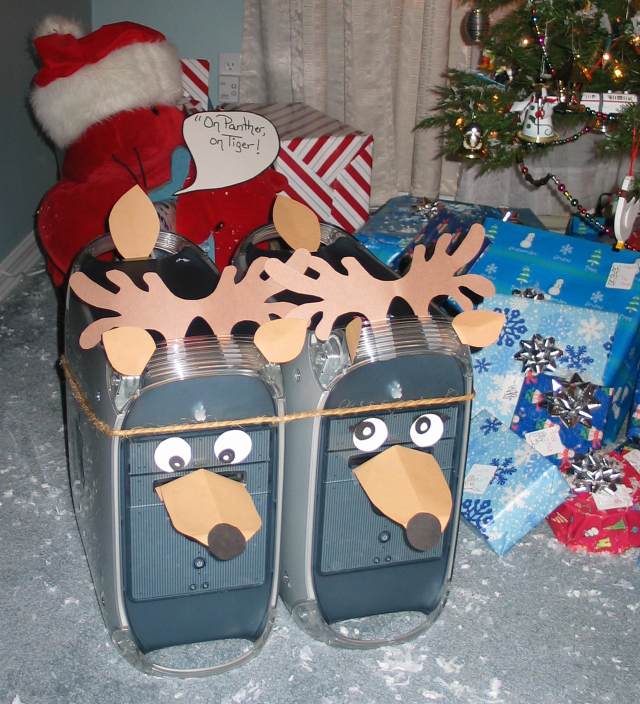
May 2005
MacOSX 10.4 Tiger came out. This supports a very nice video conference mode based on a program called iChat and a camera called iSight. I have had a pair of iSights for a while. The difference now is that iChat can do multiway video. This is much fun.
I was sent to Colorado Springs for 2 weeks on business. Being separated from my family is not something we like doing. The last time we did this for more than a few days some terrorists crashed airplains into the World Trade Center. These two events (our being appart and terrorism) seem to be linked in our heads. As a consolation we bought a new iBook. (??) Our old iBook was not powerful enough to run video. The G4 iBook for $899 includes wifi and can participate in multi-way video conferences.
Here is a photo of the Hotel I was staying in. Pikes Peak is in the background.
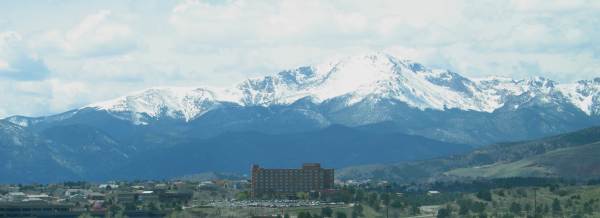
The two weeks was an adventure. It sure got long near the end. The job I was sent to do was not finishable in the limited time I had, but we made some pretty good progress on it. The video conferencing worked very well.
June 2005
Anyway, she's graduationg. So, we drove up to Vermont. Then when we left her school we drove around the great lakes. Actually we cheated in that we went south of Lake Superior. The other lakes we circled, including stops at each lake. We also went to Mackinack Island, Chicago, Toronto, Niagara Falls, and a few other tasty stops.
We had both iBooks for the trip. This was very nice. All but a few nights were at hotels that had WiFi or ethernet. We had a few bad experiences with hotels for non computer related issues. It was so bad for 2 separate nights that we got free nights stays. Eeek.
Unfortunately this trip was not as nice as last year's becuase we had to be back in Connecticutt only 10 days later so my daughter could register for classes at her new school. She's going to try Journalism or some writing related study. This is good. She's very good at editing and other journalism related persuits.
June 2005
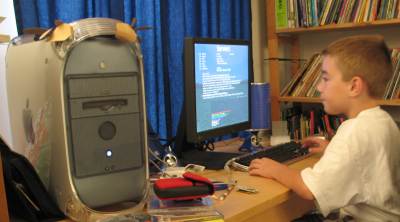
We bought Jack a 17" LCD display from NewEgg for his birthday. It is an LG1710 and cost $298. This model has both DVI and VGA input and is used with Jack's PowerMac G4. It was advertised as
LG L1710BK Black 17" 16ms LCD Monitor 250 cd/m2 550:1 0.26mm Pixel Pitch - Retail.
July 2005
All of our Vonage complaints have gone away. We had issues with drop-outs and disconnects as well as a wierd studdering audio problem. These seem to have been caused by intermittent service on the Adelphia cable modem.
Oh. Vonage dropped it's service fees. We're now at $25/month for unlimited long distance.
August 2005
I did a little web browsing research to discover how much HDs cost per gigabyte before I bought the largest capacity model on the market. I assumed $8 for shipping, $80 per drive for enclosure, cabling and controller card, and divided the total cost by number of gigabytes.
SEAGATE 400GB ST3400832AS SATA 8MB 7200RPM
$255.00 + $8 + $80 = $343 = 343/400 = .86 cents per gig
Seagate / 250GB / 7200 / 8MB /S-ATA-150 / Hard Drive with NCQ
$109 + $8 + $80 = $197 = 197/250 = .79 cents per gig
HITACHI Deskstar 7K500 0A31619 500GB 7200 RPM 16MB Cache Serial ATA II Hard Drive - OEM
$357 + $3 + $80 = $440 = 440/500 = .88 cents per gig
The 250GB was enough cheaper that I could have bought 2 of them with a dual drive enclosure. Then I could have used RAID 0 to acheive a rather high speed storage system. i went with the 500GB anyway to keep things simple. In addition the 500GB has twice as much cache and is SATAII. At some point it might end up inside the G5 at which point the density might be a feature.
Sept 29, 2005
November, 2005
Mar 31, 2006
April 24, 2006
May 2006
June 13, 2006
Western Digital 320GB 8.9MS 9MB 7200RPM 3YR $121 from TheNerds
July 2006
July 31, 2006
August 2006
September 2006
May 2007
June 2007
June 2007
In the short term I'm trying to sort and consolidate all of the movie projects that are disparately backed up on 300GB and 200GB drives all about the house.
